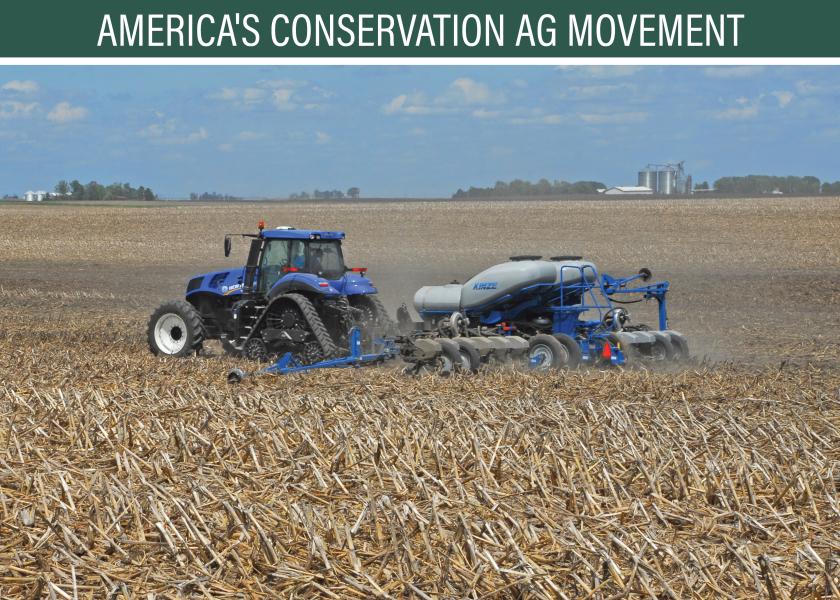Five Reasons Why I Started Using Conservation Practices On My Farm

This article was written by Keith Mears, who farms with his family near Delphi, Ind., and is a Conservation Steward with the America’s Conservation Ag Movement.
The most important step to making a change on your farm is determining why you are going to do it. Without a firm understanding of why, it will be too easy to lose motivation and change your mind when challenges arise. In order to encourage other farmers to get started, I want to explain five reasons why I started using conservation practices on my 110-acre corn and soybean farm.
1. The first reason I use conservation practices is to be the best steward I can be. One of my favorite free-time activities is kayaking on the local streams and rivers. It is sad and concerning to me how muddy-brown our streams and rivers are. I want to take responsibility for the farmland I am called to be a steward of and make sure I do my part to keep my soil on my farm. The legacy I want to leave for my community and my children is one of cleaner water and richer soils, allowing them to produce healthy reliable food and enjoy the environment for generations to come.
2. The second reason I use conservation practices is to increase soil organic matter and, in turn, increase water holding capacity. The art of farming can be boiled down to using soil and water to capture energy from the sun to produce food fuel and fiber. Considering the factors I can manage, I realize that the sun is going to come up every day and there is not a lot we can or need to do to manage that. My farm relies on rainfall for all of the water for the crops and while there is absolutely nothing I can do to change the rains, I have come to realize that I can improve the water-holding capacity of the soil by increasing organic matter and improve yields by holding more of the rains we do get on my farm for my crops to produce higher yields. A 1% increase in soil organic matter will increase the water-holding capacity in the top 6 inches of an acre by 27,000 gallons. This is roughly equivalent to the amount of water in a 1-inch rain.
3. The third reason I use conservation practices is to improve overall farm efficiency. To win in a commodity business a farmer must produce high yields at the lowest cost possible. Reducing tillage and, therefore, reducing trips across the field reduces the costs of growing a crop and improves efficiency. Two to three tillage passes are eliminated, resulting in less time, labor and fuel required to produce crops. Eliminating these tillage passes saves between $35 and $40 per acre.
4. The fourth reason I use conservation practices is to reduce the amount of equipment I need to purchase and maintain to operate my farm. I do not own a chisel plow, disk or field cultivator. I also do not need to own a high-horsepower tractor to pull these implements. Further savings are realized by not having to have a larger barn to store these extra pieces of equipment. I am able to farm using only one tractor on the entire operation. Not having to buy a high-horsepower tractor, a chisel plow, disk and field cultivator saves my farm tens of thousands of dollars of capital costs.
5. The fifth reason I use conservation practices is support from the NRCS. When deciding whether to transition to a no-till cover crop system, I reached out to the NRCS for ideas and support. The conservationists at the NRCS were able to share ideas and practices that had the highest likelihood of success in our area. I applied for and received three years of per-acre payments for no-till and cover crops through the EQIP program. These payments covered the cost of my planter pass and all costs of using a cover crop, including seed and planting. These payments reduced the risk of trying something new and gave me the confidence to get started.
I encourage anyone reading this to consider how to improve stewardship on their own farm in addition to how their management decisions impact the community and the legacy they want to leave for future generations. I also encourage you to reach out to your NRCS office and/or connect with other farmers in your area to discuss conservation practices.
Note: If you are interested in learning more about how NRCS can help you incorporate conservation practices on your land, contact Ethan White, Manager of Farmer Outreach and Engagement at Trust In Food™, a Farm Journal initiative, and he will direct you to the right resource in your state. If you would like to know more about the work Keith is doing with America’s Conservation Ag Movement, go to www.trustinfood.com/americas-conservation-ag-movement/; or, email us at conservationag@farmjournal.com.
Pollinator Habitat Fits Farmer’s Sandy Soils And Delivers A ROI







